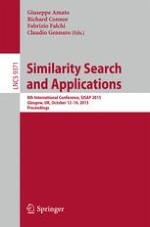2015 | Buch
Similarity Search and Applications
8th International Conference, SISAP 2015, Glasgow, UK, October 12-14, 2015, Proceedings
herausgegeben von: Giuseppe Amato, Richard Connor, Fabrizio Falchi, Claudio Gennaro
Verlag: Springer International Publishing
Buchreihe : Lecture Notes in Computer Science
